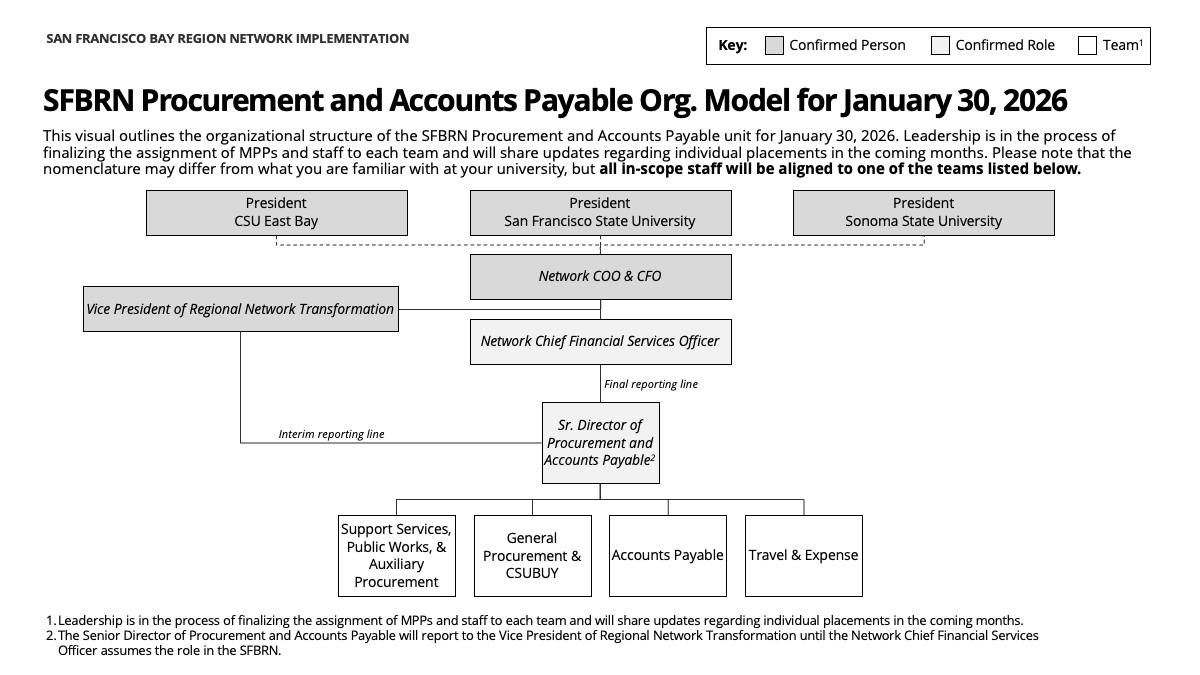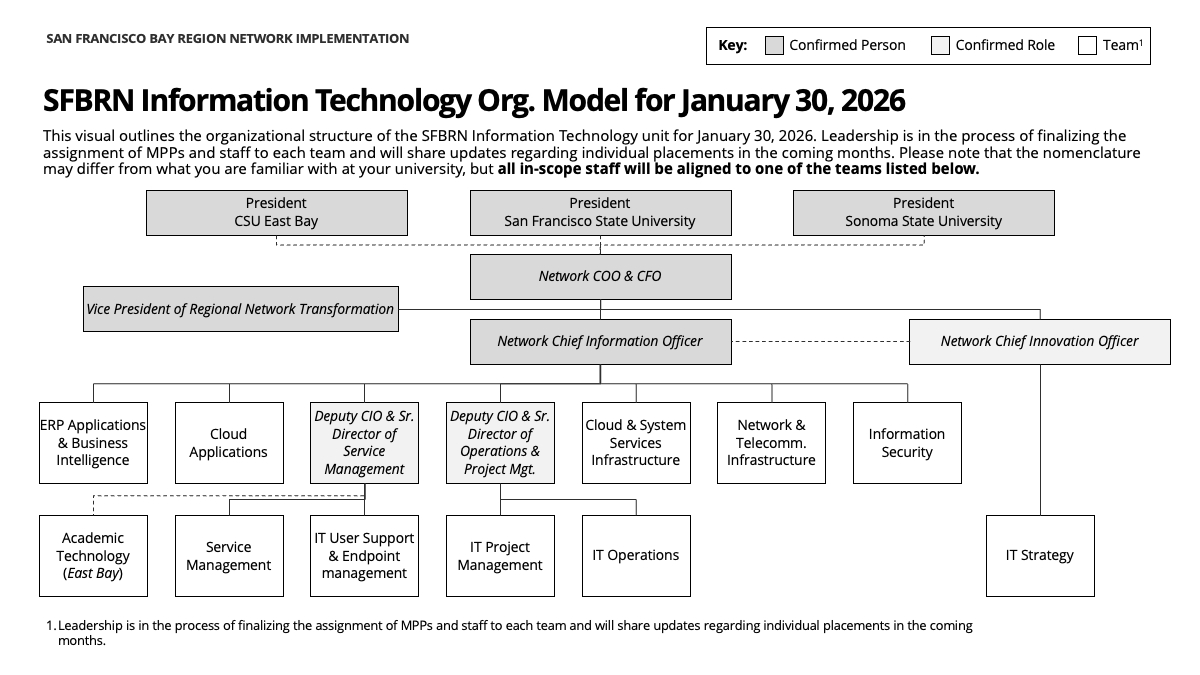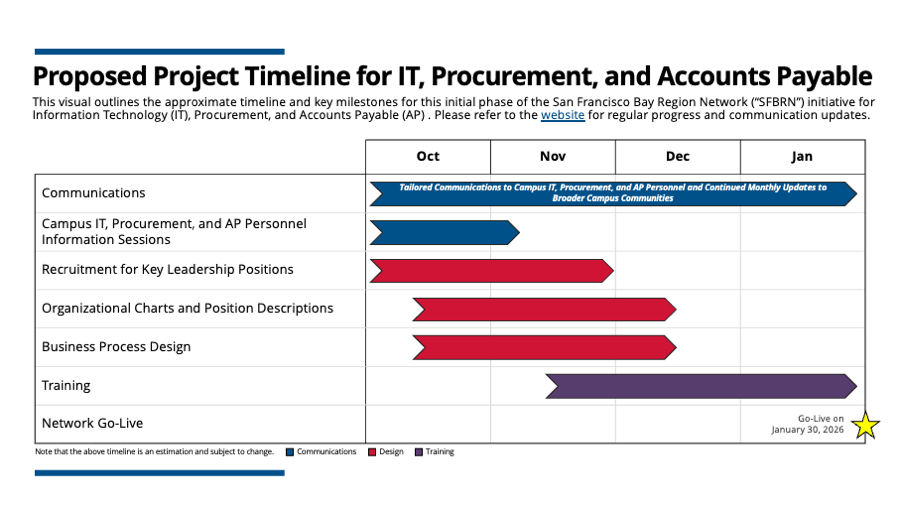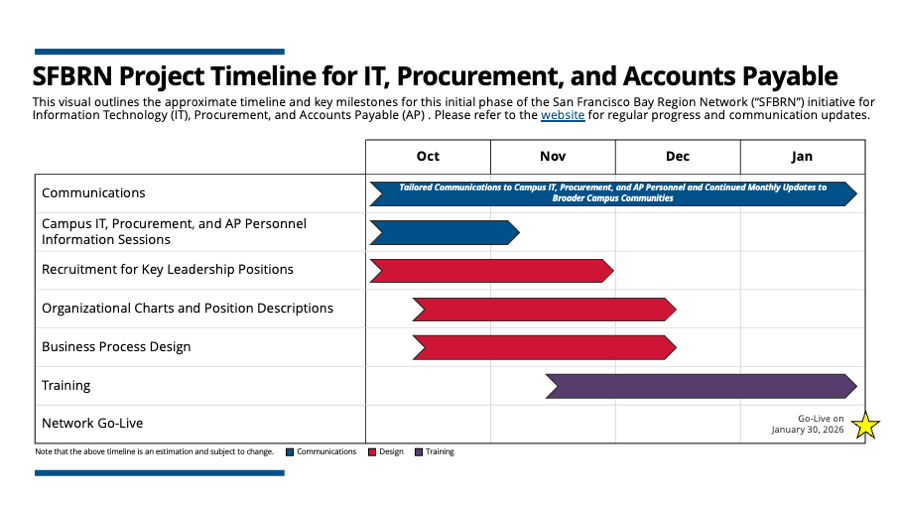Written Summaries
In November, our focus was on readiness for the January launch, continued engagement with campus partners, and refinement of core Network structures. Here’s what’s been accomplished — and what’s next:
November Achievements
-
Advanced MPP Reassignments: Continued preparation for MPP transitions into Network roles.
-
Strengthened Technology Transition Work: Coordinated across multiple IT transition teams, launched the Web & Services workgroup, and continued progress toward a unified service-oriented portal.
-
Refined Governance and Service Structures: Developed drafts of governance processes, escalation pathways, service level agreements (SLAs), and key performance indicators (KPIs).
-
Enhanced Network Support Center Planning: Advanced service catalogs, user experience design, and foundational materials for the Network’s “front door” experience.
-
Campus Engagement: Held staff forums, leadership conversations, ASI meetings, and Senate discussions across the three universities to gather feedback and address questions.
December Focus Areas
-
Distribute formal reassignment letters to IT and Procurement and Accounts Payable MPPs and move forward with the placement of IT and Procurement and Accounts Payable staff in the Network.
-
Finalize IT and Procurement & AP organizational models and related materials.
-
Continue coordinated progress on the technology transition and shared platforms.
-
Complete high-level service catalogs, process documentation, and remaining position descriptions.
-
Continue cross-campus planning related to CHRS alignment and transition readiness.
Looking Ahead
The Network remains on track for its January 30, 2026, go-live for IT, Procurement, and Accounts Payable. Human Resources is scheduled to follow in Spring 2026, aligned with the CSU’s CHRS rollout.
In October, our focus was on engagement, clarity, and design refinement. Here’s what’s been accomplished — and what’s next:
October Achievements
- Held staff and MPP information sessions across all three campuses
- Launched business process mapping workshops to capture current operations
- Appointed the Network CIO; Began recruitment for the Senior Director of Learning & Professional Development
- Advanced draft organizational models for IT, Procurement, and Accounts Payable
November Focus Areas
- Continue business process mapping and begin designing new service workflows
- Finalize selection of key Network leadership roles
- Prepare role alignments and draft onboarding plans
- Build training and communication resources for January’s launch
Looking Ahead
The Network remains on track for its January 30, 2026 go-live for IT, Procurement, and Accounts Payable, with Human Resources to follow in Spring 2026 alongside the CSU’s CHRS rollout. The latest unit-level organizational models for IT and Procurement and Accounts Payable can be found below.


In response to feedback from last month’s poll, we are pleased to begin including a written summary and high-level timeline in these monthly updates to provide greater visibility into what’s coming next.
Throughout September, we focused on refining the Network’s design and preparing for the next stage of engagement with staff. We held workshops with Human Resources (HR), Financial Services, and Accounts Payable leaders to refine operating models and consolidated IT, HR, and Procurement outputs into draft organizational models for review. We also scheduled business process mapping workshops beginning October 1, which will involve staff in documenting how current processes function to inform new designs.
We are working toward a go-live in January 2026. Key activities ahead include:
- October: Conducting business process mapping workshops; Holding Information Sessions for Campus IT, Procurement, and AP Personnel
- October–November: Designing and refining business processes; Recruiting for MPP positions
- October–December: Finalizing organizational charts
- November–January: Training; Preparing for Network launch

SFBRN Background
The San Francisco Bay Region Network (“SFBRN” or “The Network”) is a new, innovative approach to managing our back-office administrative and transactional functions. The Network will consolidate internally-facing administrative and transactional functions at Sonoma State University, San Francisco State University, and California State University, East Bay into one single cost-efficient structure.
By integrating back-office administrative and transactional operations into a single, shared core, the Network seeks to enhance efficiency, reduce duplication, and optimize resource allocation, while maintaining each university’s unique identity, accreditation, and academic mission. This approach moves beyond traditional cost-reduction strategies, offering a forward-looking solution to the urgent fiscal and demographic challenges facing our institutions. The goal will be to improve operational function through collaboration across campuses.
The terms “back-office” and/or “transactional” refer to administrative and support functions that operate behind the scenes to enable the core academic mission of teaching, research, and student success and engagement. These services typically include financial services, human resources, procurement, accounts payable, facilities management, and many aspects of information technology. They are essential for institutional efficiency, compliance, and strategic planning, but they are not directly involved in instructional delivery.
The term “front-facing” refers to functions that provide direct service to campus communities. IT, HR, procurement, and accounts payable all have elements that are front-facing (the IT Help Desk, payroll and benefits advising, and personalized support for CSU Buy or Concur are good examples), and employees in those units will continue to provide direct support on each campus through the Network.
We strive to strengthen the individual viability of our three universities—ensuring continuous service to the extended communities in our shared geographic region, providing access to higher education, and preparing our local and regional workforce. In light of ongoing demographic and enrollment declines, we are creating a single effective and cost-efficient structure, the San Francisco Bay Region Network, to support long-term sustainability and student success.
The Network is grounded in the following guiding principles:
-
Forming the Network is a fundamental step in ensuring that we align how we use our scarce resources to support student success. By increasing efficiency, reducing costs, and working collaboratively, we ensure that administrative and transactional services continue unimpeded despite funding challenges and prioritize resources for our critical teaching and learning missions. .
-
The Network will challenge the status quo and long-held traditions that are impediments to change and work with a sense of urgency.
-
The Network will focus first on administrative services but does not rule out a networked approach to some student services, library, or academic platforms and programs and encourages all manner of collaboration among the three universities.
-
The Network will streamline and standardize processes – consolidating where possible – and will utilize uniform technology systems and platforms.
-
The Network will ultimately increase administrative efficiencies for all three universities and will strive to improve the current level of service provided for our administrative functions.
-
Workforce reductions are a necessary component of achieving economies of scale. The Network will aim as much as possible to achieve workforce reductions via attrition, functional reassignments, and opportunities for professional growth.
-
Design and implementation decisions will be made in consultation with campus experts with the explicit goal of developing uniform practices across all three universities. Stakeholders will engage in identifying promising practices.
-
Design and implementation decisions will be based on data and national best practices.
-
The Network will communicate design and implementation decisions and project progress transparently and frequently.
-
These separately accredited universities must maintain their distinct characteristics, accreditation standards, and service to their surrounding communities during and after Network implementation.
These guiding principles were developed through discussions with the Network university presidents and other Network leadership.
Launched in August 2023, the Multi-University Collaboration Initiative arose from CSU presidents’ desire to explore new ways to collaborate across the system. Key opportunities for increased functional collaboration were initially identified through focus groups, workshops, and interviews with representatives across the system. Through continued analysis and discussion led by the initiative’s steering committee – which is composed of presidents and leaders across functional areas and universities – the CSU selected three focus areas for the first wave of design and implementation: benefits administration, information security, and procurement.
The two initiatives have shared goals and exemplify forms of collaboration at the CSU. Multi-U’s work on CSUBUY (systemwide Procure-to-Pay implementation), for example, will serve as a foundation for the Network’s efforts to integrate procurement functions across the three universities. Given the two initiatives’ shared goals and vision, the project teams will maintain communication and share relevant updates as both initiatives progress.
To learn more about this effort, please visit the Multi-U website.
SFBRN Governance and Communications
An important element of this work is providing transparency in how decisions impacting the Network will be made. The governance for this initiative is as follows:
-
Network university presidents: The three Network university presidents have overall authority and responsibility for the success of the Network.
-
Network leadership: The three Network university presidents have delegated authority and responsibility for the operational design, implementation, and success of the Network to the Network’s Vice President & CFO, Jeff Wilson, and the Network’s leadership team, which encompasses experienced administrators coming to the Network from all three campuses.
-
Network steering committee: The three Network university presidents and Network leadership will work closely with representatives from the Chancellor’s Office for advisement and guidance on key decisions throughout the initiative.
-
Stakeholder engagement: Throughout the design and implementation, the Network project team will engage with key stakeholders across the three universities to identify promising practices that will be brought to the Network leadership and university presidents.
You may be contacted by Network leadership, the project team, or our Deloitte partners for input via a virtual meeting, in person meeting, email, or survey. It is critical to our team that we use quantitative and qualitative information, including the expertise of existing staff within the universities today, to ensure the success of the project. If you have questions, feedback, or collaboration ideas, we would love to hear from you. Please reach out to the Network project team by emailing us at info@sfbrn.calstate.edu.
You can stay up to date about the Network through this website, which will be updated with key milestone updates and answers to frequently asked questions. In addition, we will be sharing a Monthly Update at the beginning of each month, which will have the latest information about progress and timelines for implementation. If you would like to learn more, or submit questions or feedback, please reach out to the SFBRN project team by filling out this anonymous survey.
SFBRN Scope and Timeline
Information Technology (IT), Human Resources (HR), and Procurement & Accounts Payable (AP) (P2P) are the administrative areas in-scope for January 2026. Because of the timeline for implementation of the Common Human Resource System (CHRS), a systemwide initiative, the implementation of Human Resources into the Network will be delayed until summer 2026.
The Network university presidents identified Information Technology, Human Resources, Procurement, and Accounts Payable as having back-office functions that presented opportunities to achieve the Network’s vision to enhance efficiency, reduce duplication, and optimize resource allocation. Subsets of these functions will be integrated into the Network by January 2026. Because of the timeline for implementation of the Common Human Resource System (CHRS), a systemwide initiative, the implementation of Human Resources into the Network will be delayed until a later phase.
It is important to note that additional functions will also be integrated into the Network in the future as the initiative continues.
The Network is officially scheduled to begin delivering Information Technology (IT), Procurement, and Accounts Payable services (AP) by January 30, 2026.
Please see the following timeline for information about the work happening in the Network between now and our January implementation date:
- October: Conducting business process mapping workshops, Campus IT, Procurement, and AP Personnel Information Sessions
- October–November: Designing and refining business processes; Recruiting for key leadership positions
- October–December: Finalizing organizational charts
- November–January: Training; Preparing for Network launch

Looking beyond January 2026, we anticipate focusing in the short term on additional back-office Financial Services and Human Resources functions.
Network Staffing
Network roles will be primarily staffed by current CSU employees from the three Network universities. The following leadership positions will be filled by competitive searches managed by the Office of Talent Acquisition at the Chancellor’s Office:
-
Head of Network Information Technology
-
Senior Director of Network Learning and Professional Development
-
Head of Network Financial Services
-
Head of Network Human Resources
All Network staff will retain their current locus of employment with their respective university. Network staff will retain their current conditions of employment. Independent of their employment, Network staff will report up through the Network leader.
The Project Implementation Team currently consists of four positions:
Project Lead: Jeff Wilson, Vice President of Administration and Finance and CFO for San Francisco State University and Interim VPAF and CFO for Sonoma State serves as the COO for the SFBRN. Mr. Wilson was appointed by the three Presidents of SSU, SFSU, and CSUEB.
Vice President, Regional Network Transformation: Dr. Karen Moranski, former Vice President for Academic Affairs and Provost at Sonoma State is serving as VPRNT. This position is a full-time, three-year position appointed by the three Presidents.
Communications Lead: Veronica Salvador, Director, Administrative Processes in Administration and Finance for Cal State East Bay, serves as the Communications Lead for the SFBRN. Veronica Salvador is appointed to a temporary position that represents expanded responsibilities to her full-time position at CSUEB.
Project Manager: Cristal Wallin, Director of Administration and Strategic Planning at San Francisco State, is appointed to a temporary position that represents expanded responsibilities to her full-time position at SFSU.
